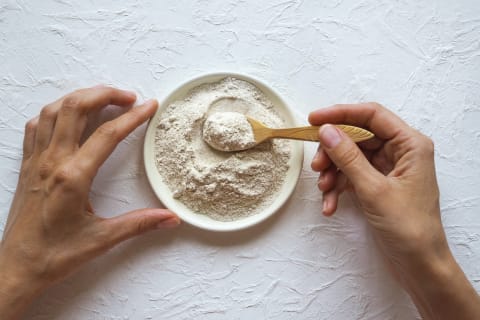Advertisement
These Hormones Might Be The Cause For Your PMS Symptoms

Many women hate their period. They anticipate their menstrual cycle as a dreadful few days to a week they have to plan their life around every single month. They live in fear of raging premenstrual tension syndrome (PMS) symptoms like mood changes, anxiety, headaches, gastrointestinal symptoms, tender breasts, and fatigue. Heavy menstrual cramping and bleeding only further support that negativity. Sadly, this occurs in 30 to 40 percent of the reproductive female population.
So what's really to blame for these symptoms? In my experience, PMS in many patients is associated with higher estrogen and lower progesterone states. Estrogen is a proliferative hormone, meaning it causes the lining of your uterus to grow or thicken. The higher your estrogen, the thicker it gets and the more you bleed. Progesterone is a more soothing, calming hormone. It's also an anti-proliferative hormone, meaning it keeps that growth in check.
Ultimately, you want to have a good balance of estrogens and progesterone and not be estrogen-dominant and low on progesterone. If we divided your 28-day cycle into four weeks, week one being the week of bleeding, most women feel worse week four, the week preceding bleeding. This is likely due to progesterone dropping. In fact, many women are so sensitive to this fluctuation that the drop triggers headaches and other symptoms.
But what if week four of your cycle didn't have to be so dreadful? Consider these natural solutions to reduce high estrogen and boost progesterone—ultimately improving PMS symptoms and that heavy bleeding!
1. Change your diet to support estrogen-progesterone balance.
Believe it or not, some foods can increase estrogen. That's the bad news. The good news is that if your goal is to keep estrogen down, avoiding or even just limiting certain foods can help you accomplish your goal. In just one example, many patients with heavy bleeding have a condition called endometriosis. Research shows a dairy-free diet may help reduce inflammation and improve endometriosis. I have seen this both in patients and in myself personally. If you want to change your diet, you can start with the following:
- Avoid meat from animals that have been given hormones.
- Eat organic when you can.
- Also reduce soy products like tofu and miso, reduce flaxseeds and sesame seeds, and beans.
- Increase foods that boost progesterone like yams as well as oily fish like sardines, mackerel, and salmon.
It's a good idea to not only remove trigger foods, but consider an anti-inflammatory diet. This means avoiding foods that you might be sensitive to—which you can be tested for or find out for yourself using an elimination diet. Some other changes that might be helpful include:
- Increasing cruciferous vegetables can help with proper estrogen clearance.
- Avoiding caffeine, which only robs you of nutrients like magnesium that can help with cramping.
- Eating to balance your blood sugar, starting your day with healthy fats and protein.
2. Reduce stress with deep breathing and calming exercises.
Hormones are produced by what I call our "A team"—which is our sex organs like the ovaries in women and testes in men—but also by our "B team," which consists of our adrenal glands. In reality, this means that stress is your body's biggest hormone hijacker. The more stress you are under, the less your "B team" can help with hormone production.
Considering lifestyle changes like setting healthy boundaries and saying no to what is not an absolute "yes" can help your body keep functioning as it should. Deep breathing, meditation, and calming exercise like yoga have proved helpful for reducing stress as well.
3. Consider supplementation with vitamins, minerals, and herbs.
Many of us are nutritionally deficient and don't even realize it. Sadly, our foods aren't as nutritionally dense as they used to be, and we may not be getting the ones that are essential for hormone production.
The mineral magnesium is soothing and calming, excellent for reducing menstrual cramps, assisting with sleep, reducing headaches, and even boosting mood. It also is a cofactor for both progesterone production and neurotransmitter production like serotonin. Vitamins are very important for your adrenals and for energy during this time of the month. B vitamins, specifically, help the liver break down estrogen levels to control its amount and maintain hormonal balance. B's are also important for neurotransmitter production like serotonin (which makes you feel good). Lastly, omega-3 fatty acids like fish oil are anti-inflammatory, which can help reduce menstrual cramps and actually reduce heavy bleeding.

Other cultures have used herbs for centuries to help boost hormone levels. Adaptogenic herbs may help the body adapt to stress. Rhodiola is thought to support the nervous system, mood, mental clarity, performance, and sleep. Eleutherococcus (ginseng) may help with memory, endurance, and energy. Schisandra may help with mental clarity, a healthy stress response, and emotional well-being. Ashwagandha's benefits are important for memory, mood, energy, and endurance, and it also helps to improve cortisol and thyroid levels. Vitex can support the pituitary gland to produce LH necessary for the body to produce progesterone and to ovulate. DIM may be very helpful in clearing our excess estrogen from the body.
It's always a good idea to work with your doctor, a functional medicine expert, or a hormone specialist when considering supplementing. They can help you narrow down the options and find the nutrient and dosage that will work for you.
4. Have your hormones checked.
Your heavy bleeding could also stem from having poor thyroid function. If your most important thyroid hormone, your free T3, is on the low end, find a provider who will help you optimize it. By testing your hormones, you can also discover whether you have higher estrogen levels. If natural remedies to boost progesterone aren't effective, consider natural progesterone replacement therapy. I've seen this help a countless number of patients.
Lastly, when you're dealing with a hormone imbalance, it's a good idea to choose safe personal care products that are free from endocrine-disrupting chemicals like parabens and phthalates. Consider using the Environmental Working Group to learn whether your products are safe or only contributing to your PMS. Hopefully, these five steps can help you no longer dread that monthly cycle!
Watch Next
Enjoy some of our favorite clips from classes
Enjoy some of our favorite clips from classes
What Is Meditation?
Mindfulness/Spirituality | Light Watkins
Box Breathing
Mindfulness/Spirituality | Gwen Dittmar
What Breathwork Can Address
Mindfulness/Spirituality | Gwen Dittmar
The 8 Limbs of Yoga - What is Asana?
Yoga | Caley Alyssa
Two Standing Postures to Open Up Tight Hips
Yoga | Caley Alyssa
How Plants Can Optimize Athletic Performance
Nutrition | Rich Roll
What to Eat Before a Workout
Nutrition | Rich Roll
How Ayurveda Helps Us Navigate Modern Life
Nutrition | Sahara Rose
Messages About Love & Relationships
Love & Relationships | Esther Perel
Love Languages
Love & Relationships | Esther Perel


















